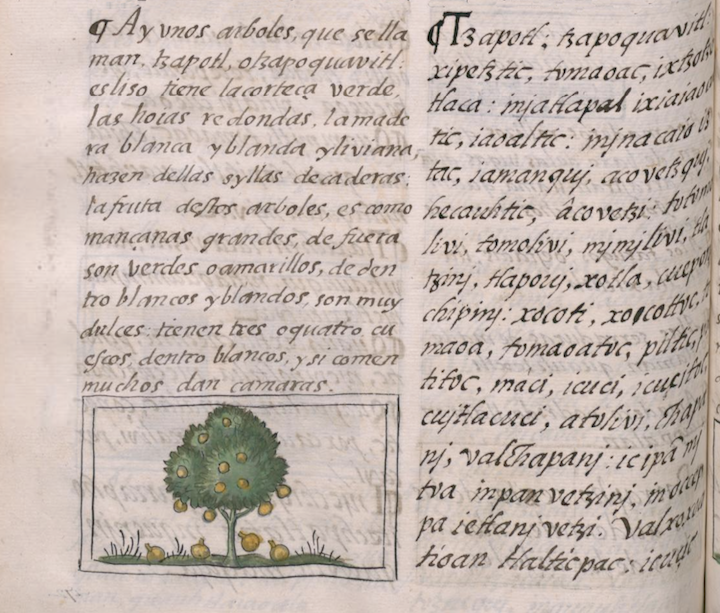tzapocuahuitl (FCbk11f120v)
This iconographic image shows a (tzapocuahuitl) (zapote tree) bearing its fruit, (tzapotl) (sapota, zapote). It appears on folio 120 verso in Book 11, “Earthly Things,” of the General History of the Things of New Spain, also known as the Florentine Codex. There are a number of entries devoted to varieties of such trees and fruits running across several subsequent pages. This iconographic image presents a frontal view of the tree. Its foliage is shaded in greens with leaf-like elements giving it some depth and contour. The tree bears roundish, yellow fruit, some superimposed on the foliage, others hanging below it. Other fruit has fallen to the ground; one is in the act of falling (in motion). On the fallen zapotes a kind of stem can be seen protruding from their tops. The tree trunk forks into three parts just below the foliage. No roots are showing, as might have been seen in earlier manuscripts. Altogether, the artist’s rendition betrays a good deal of European cultural influence.
Robert Haskett
According to the English translation of the alphabetic Nahuatl text, “the sopadilla tree (tzapoquahuitl) is smooth, thick, shiny on the surface. Its leaves are each rounded on the surface: round. Its wood is white, soft, light, buoyant. It comes up. Each bud swells; they swell, they enlarge, break, open, burst, blossom, form small fruit. It forms fruit; they extend, growing larger, enlarging. They are tender. They extend, becoming tender. They mature, they ripen; they extend, ripening. They become overripe, very soft; they fall to the ground; they fall down. Thus it is said of one who has excelled, when once again he falls down, ‘The fruit comes to earth; ripened, it falls to the ground.’” The artist who created the image perfectly captures the language of this text (or vice versa), showing fallen fruit on the ground and another in the act of falling. The English translation is found in Sahagún, Fray Bernardino, General History of the Things of New Spain: Book 11 – Earthly Things. Translated and edited by Charles E. Dibble and Arthur J. O. Anderson. Salt Lake City and Santa Fe: The University of Utah, The School of American Research and the Museum of New Mexico, 1963, 116.
Robert Haskett
Tzapotl: tzapoquauitl
tzapotl: tzapocuahuitl
Robert Haskett
1577
Robert Haskett
trees, árboles, zapotes, sapotas, fruits, frutas
zapo(tl), sapota, zapote, a type of fruit, https://nahuatl.wired-humanities.org/content/tzapotl
tzapocuahuitl, a fruit-bearing tree; a zapote tree, https://nahuatl.wired-humanities.org/content/tzapocuahuitl-0
el zapote
Robert Haskett
Library of Congress, https://www.loc.gov/item/2021667856/
The Library of Congress is unaware of any copyright or other restrictions in the World Digital Library Collection. Absent any such restrictions, these materials are free to use and reuse. Researchers are encouraged to review the source information attached to each item. If you do publish anything from this database, please cite the Visual Lexicon of Aztec Hieroglyphs.



